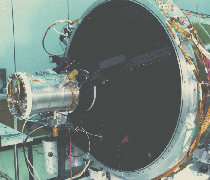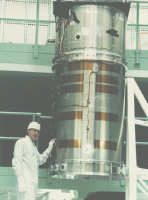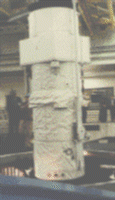|
|||||||||||||||||||
|
|
|||||||||||||||||||
|
|



Photo captions: (left) HUT under construction at the JHU Applied Physics Lab in Laurel, MD. (middle) Future Payload Specialist Sam Durrance stands with a nearly completed HUT during testing in 1985. (right) A completed HUT enters a thermal vacuum test chamber at NASA/GSFC.
WHAT WAS HUT AND WHAT DID IT DO?
(The following text provides a brief overview of the design and functionality of the HUT instrument. Please click on highlighted items for more detailed information.)
Visible light is a tiny portion of the entire electromagnetic spectrum of wavelengths, which encompasses everything from X-rays and gamma rays to infrared radiation and radio waves. Much of this radiation gets blocked by our earth's atmosphere, which is good because it could be harmful to life on earth. However, trying to understand the universe around us fully just using the tiny optical "window" of the spectrum is impossible. Many phenomena in the universe emit most of their light in other parts of the electromagnetic spectrum, and can only be understood by getting instruments above the cloak of our atmosphere.
At wavelengths just shortward of visible light lies the ultraviolet spectrum, a region of invisible light that is especially rich in information about our universe. While several telescopes have been placed in orbit to study ultraviolet light, including the Hubble Space Telescope, there is one region in the farthest reaches of this spectral range that, for technical reasons, has received very little attention. The NASA-funded Hopkins Ultraviolet Telescope (HUT) was designed and built by astrophysicists and engineers at the Johns Hopkins University specifically to investigate this little-explored region of the far-UV spectrum. (Click here for a labeled line diagram of the telescope.)
The telescope weighs 1,700 pounds, is 12 feet long, 4 feet wide and has a 36-inch-diameter primary mirror. (See The HUT Technical Summary for more details.) The mirror is coated with a special material that gives it high reflectivity farther into the ultraviolet than other NASA space missions. HUT incorporates a device called a spectrograph at the prime focus of the telescope to separate ultraviolet light from an astronomical object into its component wavelengths for detailed analysis. Just as visible light can be separated into its component colors, or wavelengths, ultraviolet light can be split into a spectrum of wavelengths. HUT's sensitive spectrograph records this ultraviolet spectrum electronically and transmits the information to earth. (Click here to see an example HUT spectrum.) Scientists studying these data can learn about the chemical composition, temperatures, densities, and other properties of astronomical objects in ways that are impossible from optical data alone.
HUT is carried into orbit on the space shuttle and is operated with other specialized telescopes directly from the payload bay using various components of NASA's Spacelab. (Click here for a line diagram.) This package of telescopes, called the Astro Observatory, first flew in December 1990 as the Astro-1 mission, and then again in March 1995 as the Astro-2 mission. Over 300 astronomical objects have been observed with HUT on the two missions, opening the window on the far-ultraviolet spectral region for many of these objects for the first time.
HUT has been used to perform investigations of many different kinds of astronomical objects. Scientific Results from HUT provides an overview of some of the HUT data that have been published to date.
|
|
|




 Follow Us
Follow Us